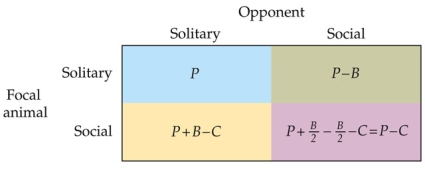Refer to the figure. The figure shows a matrix of fitness payoffs for interactions between two behaviorally different types of gulls: those that always fish for themselves and those that sometimes steal fish from others. P stands for the baseline fitness that a gull derives when it fishes for itself. B is the fitness gained by a thief when it steals a fish from a fish-for-self type. C is the fitness cost associated with an attempt to steal a prey.
The figure shows a matrix of fitness payoffs for interactions between two behaviorally different types of gulls: those that always fish for themselves and those that sometimes steal fish from others. P stands for the baseline fitness that a gull derives when it fishes for itself. B is the fitness gained by a thief when it steals a fish from a fish-for-self type. C is the fitness cost associated with an attempt to steal a prey.
What causal question is the model designed to answer?
A) How can a hereditary thief phenotype spread in a population of fish-for-self types?
B) What are the fitness costs and fitness benefits of fish-for-self versus thief phenotypes?
C) When can group selection cause evolutionary change to take place?
D) What are the circumstances under which maladaptive traits can take over a population?
Correct Answer:
Verified
Q2: Refer to the following paragraph.
In the evening,
Q3: Refer to the following paragraph.
In the evening,
Q4: Refer to the following paragraph.
In the evening,
Q5: In order to test the selfish herd
Q6: If a foraging tactic is "optimal," this
Unlock this Answer For Free Now!
View this answer and more for free by performing one of the following actions

Scan the QR code to install the App and get 2 free unlocks

Unlock quizzes for free by uploading documents